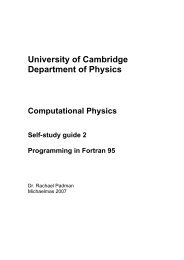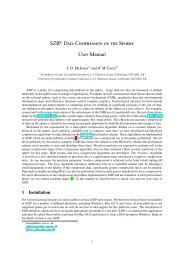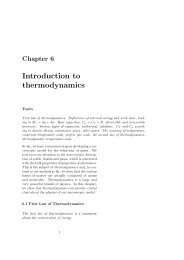Bayesian Methods for Astrophysics and Particle Physics
Bayesian Methods for Astrophysics and Particle Physics
Bayesian Methods for Astrophysics and Particle Physics
You also want an ePaper? Increase the reach of your titles
YUMPU automatically turns print PDFs into web optimized ePapers that Google loves.
2.3 Nested Sampling<br />
could, however, underestimate the evidence in (<strong>for</strong> example) cases where the pos-<br />
terior contains any narrow peaks close to its maximum. Skilling (2004) provides<br />
an adequate <strong>and</strong> robust condition by determining an upper limit on the evidence<br />
that can be determined from the remaining set of current active points. By se-<br />
lecting the maximum-likelihood Lmax in the set of active points, one can safely<br />
assume that the largest evidence contribution that can be made by the remaining<br />
portion of the posterior is ∆Zi = LmaxXi, i.e. the product of the remaining prior<br />
volume <strong>and</strong> maximum likelihood value. We choose to stop when this quantity<br />
would no longer change the final evidence estimate by some user-defined value<br />
(we use 0.1 in log-evidence).<br />
2.3.3 Posterior Inferences<br />
Once the evidence Z is found, posterior inferences can be easily generated using<br />
the full sequence of discarded points from the nested sampling process, i.e. the<br />
points with the lowest likelihood value at each iteration i of the algorithm. Each<br />
such point is simply assigned the weight<br />
pi = Liwi<br />
. (2.7)<br />
Z<br />
These samples can then be used to calculate inferences of posterior paramet-<br />
ers such as means, st<strong>and</strong>ard deviations, covariances <strong>and</strong> so on, or to construct<br />
marginalized posterior distributions.<br />
2.3.4 Evidence Error Estimation<br />
If we could assign each Xi value exactly then the only error in our estimate of<br />
the evidence would be due to the discretisation of the integral (2.5). Since each<br />
ti is a r<strong>and</strong>om variable, however, the dominant source of uncertainty in the final<br />
Z value arises from the incorrect assignment of each prior volume. Fortunately,<br />
this uncertainty can be easily estimated.<br />
Shaw et al. (2006b) made use of the knowledge of the distribution P(ti) from<br />
which each ti is drawn to assess the errors in any quantities calculated. Given<br />
23






